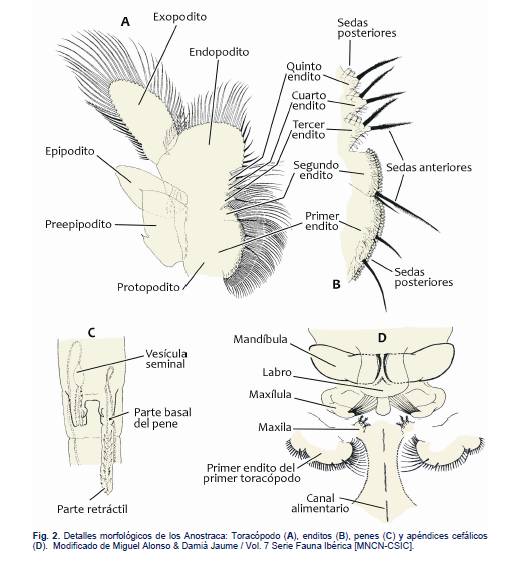Crustaceans - Large Branchiopoda

> Branchipus cortesi
Order: Anostraca (“fairy shrimp”)
Fairy-shrimp are temporary freshwater crustaceans adapted to very concrete conditions of the aquatic environment and with very strict tolerances to certain environmental factors and are therefore considered good ecological indicators.
They differ from the remaining Branchiopodes due to the lack of carapace. This temporary freshwater crustaceans can reach to an maximum length of 2.2cm.
Crustaceans of the order Anostraca, have separated sexes but with a clear sexual dimorphism, that is, the males and the females have a different aspect. Males have retractable penis and antennas developed to grab the female during copulation. The females have smaller antennas and have a small ovissac (sac of cysts, i.e. eggs) in the ventral protuberance, of very dark color, almost black and with a white central spot, limited to the first abdominal somite. It is in this ovissaco that the eggs mature and are stored until their release. Image A shows a female with the bag of cysts and the image B shows a male.

Image A - Female of Branchipus cortesi. Photo of Liliana Barosa

Image B - Male of Branchipus cortesi. Photo of Liliana Barosa
These temporary freshwater crustaceans live in temporary ponds with few or no predators. One very interesting feature is that these fairy-shrimps swim freely with the ventral upwards through the water column. Displacement, respiration and feeding are done together by tapping toracopods which remove particles from the water column, such as phytoplankton, protozoa, organic debris or even clay particles because they have some organic matter in their composition. These foods accumulate in the alimentary canal and are punctured to the mouth with the help of the first toracopods. The following image shows some details of the morphology of these animals.

Life cycle:
The active stage of the life cycle takes place in the initial phase of the flooding of the biotope, extending, under optimum conditions, up to 4 months.
Feeding:
They are filterers feeders because they swim freely in the water column "filtering" what they find, such as phytoplankton, protozoa, organic debris or even clay particles because they have in their composition some organic matter that serves as food.
Reproduction:
Fertilization is internal. Before releasing the eggs (cysts), the females store the cysts in the ovissac until they are ready. The number of cysts per posture is directly related to the size of the female.
Temporary freshwater ponds, such as Mediterranean Temporary Ponds (Priority Habitat 3170 - Directive 92/43 / EEC).
It is an iberian endemism, having been found in the watershed of the rivers Douro, Tagus, Guadiana and Guadalquivir. In Portugal it was found along the southwest coast, since Vila Nova de Milfontes until Vila do Bispo, in the central region of Alentejo and Algarve, and in the Natural Park of the Guadiana Valley.
The threats to this species are directly related to the loss and degradation of its habitat. Up to this date it has no legal protection status but the habitat where it occurs is a priority for conservation mentioned in the Habitat Directive (92/43/CEE).


